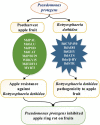Endophytic bacterium Pseudomonas protegens suppresses mycelial growth of Botryosphaeria dothidea and decreases its pathogenicity to postharvest fruits
- PMID: 36569085
- PMCID: PMC9771998
- DOI: 10.3389/fmicb.2022.1069517
Endophytic bacterium Pseudomonas protegens suppresses mycelial growth of Botryosphaeria dothidea and decreases its pathogenicity to postharvest fruits
Abstract
Apple (Malus domestica Borkh.), one of the most economically important fruits widely consumed worldwide, has been suffering from apple ring rot caused by Botryosphaeria dothidea, which dramatically affects its quality and yield. In the present study, we demonstrated that Pseudomonas protegens, isolated from Chinese leek (Allium tuberosum), significantly suppressed the mycelial growth and propagation of B. dothidea, respectively, further displayed a considerably inhibitory effect on the apple ring rot of postharvest fruits. In addition, P. protegens significantly improved the total soluble solid/titrable acidity (TSS/TA) ratio and soluble sugar/titrable acidity (SS/TA) ratio and drastically maintained the fruit firmness. Further analysis manifested that P. protegens substantially induced the defense-related genes such as MdGLU, MdPAL, MdPOD, MdCAL, and transcription factors related to the resistance to B. dothidea, including MdWRKY15, MdPUB29, MdMyb73, and MdERF11 in apple fruits. Meanwhile, P. protegens considerably restrained the expressions of the pathogenicity-related genes in B. dothidea, including the BdCYP450, BdADH, BdGHY, BdATS, Bdα/β-HY, and BdSTR. By inference, P. protegens inhibited the apple ring rot on postharvest fruits by activating the defense system of apple fruit and repressing the pathogenic factor of B. dothidea. The study provided a theoretical basis and a potential alternative to manage the apple ring rot on postharvest fruits.
Keywords: apple ring rot; biological control; defense-related genes; fruit quality; pathogenicity-related genes.
Copyright © 2022 Huang, Liu, Li, Shan and Duan.
Conflict of interest statement
The authors declare that the research was conducted in the absence of any commercial or financial relationships that could be construed as a potential conflict of interest.
Figures








Similar articles
-
Bioactivities evaluation of an endophytic bacterial strain Bacillus tequilensis QNF2 inhibiting apple ring rot caused by Botryosphaeria dothidea on postharvest apple fruits.Food Microbiol. 2024 Oct;123:104590. doi: 10.1016/j.fm.2024.104590. Epub 2024 Jul 2. Food Microbiol. 2024. PMID: 39038895
-
Endophytic Bacterium Serratia plymuthica From Chinese Leek Suppressed Apple Ring Rot on Postharvest Apple Fruit.Front Microbiol. 2022 Mar 3;12:802887. doi: 10.3389/fmicb.2021.802887. eCollection 2021. Front Microbiol. 2022. PMID: 35310399 Free PMC article.
-
Efficacy of Dimethyl Trisulfide on the Suppression of Ring Rot Disease Caused by Botryosphaeria dothidea and Induction of Defense-Related Genes on Apple Fruits.Front Microbiol. 2022 Feb 7;13:796167. doi: 10.3389/fmicb.2022.796167. eCollection 2022. Front Microbiol. 2022. PMID: 35197948 Free PMC article.
-
Recent advances in research on biocontrol of postharvest fungal decay in apples.Crit Rev Food Sci Nutr. 2023;63(30):10607-10620. doi: 10.1080/10408398.2022.2080638. Epub 2022 May 24. Crit Rev Food Sci Nutr. 2023. PMID: 35608023 Review.
-
Molecular basis of pathogenesis of postharvest pathogenic Fungi and control strategy in fruits: progress and prospect.Mol Hortic. 2021 Jun 16;1(1):2. doi: 10.1186/s43897-021-00004-x. Mol Hortic. 2021. PMID: 37789422 Free PMC article. Review.
Cited by
-
Assessment of Chemical and Biological Fungicides for the Control of Diplodia mutila Causing Wood Necrosis in Hazelnut.Plants (Basel). 2024 Sep 30;13(19):2753. doi: 10.3390/plants13192753. Plants (Basel). 2024. PMID: 39409622 Free PMC article.
-
Metabolome and Transcriptome Profiling Reveals the Function of MdSYP121 in the Apple Response to Botryosphaeria dothidea.Int J Mol Sci. 2023 Nov 13;24(22):16242. doi: 10.3390/ijms242216242. Int J Mol Sci. 2023. PMID: 38003432 Free PMC article.
References
-
- Aiello D., Restuccia C., Stefani E., Vitale A., Cirvilleri G. (2019). Postharvest biocontrol ability of pseudomonas synxantha against Monilinia fructicola and Monilinia fructigena on stone fruit. Postharvest Biol. Technol. 149, 83–89. doi: 10.1016/j.postharvbio.2018.11.020 - DOI
-
- Andreolli M., Zapparoli G., Angelini E., Lucchetta G., Lampis S., Vallini G. (2019). Pseudomonas protegens MP12: a plant growth-promoting endophytic bacterium with broad-spectrum antifungal activity against grapevine phytopathogens. Microbiol. Res. 219, 123–131. doi: 10.1016/j.micres.2018.11.003, PMID: - DOI - PubMed
-
- Chen Y., Li F., Tian L., Huang M., Deng R., Li X., et al. (2017). The phenylalanine ammonia Lyase gene LjPAL1 is involved in plant defense responses to pathogens and plays diverse roles in Lotus japonicus-rhizobium symbioses. Mol. Plant-Microbe Interact. 30, 739–753. doi: 10.1094/MPMI-04-17-0080-R, PMID: - DOI - PubMed
LinkOut - more resources
Full Text Sources

